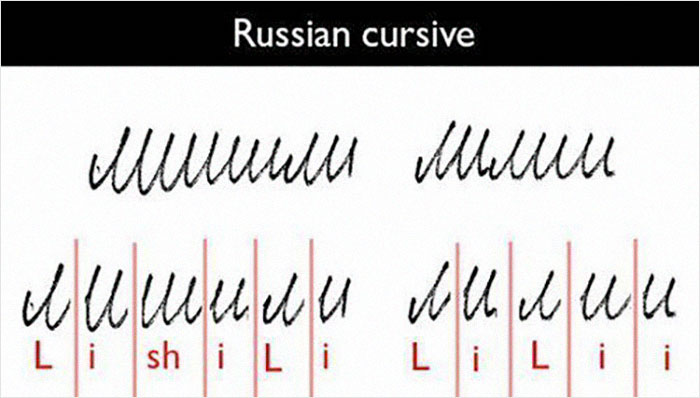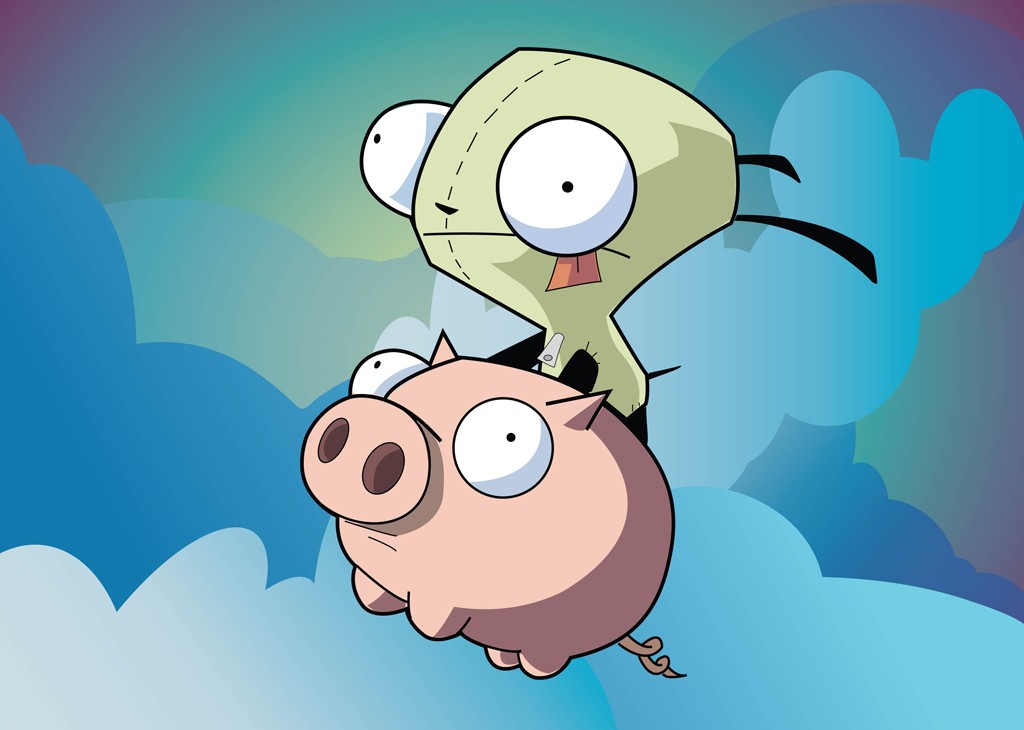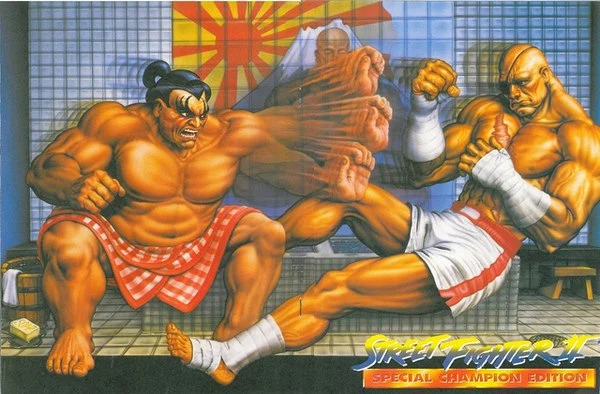Alt text:
𝓘 𝓽𝓱𝓲𝓷𝓴 𝓬𝓪𝓹𝓲𝓽𝓪𝓵 𝓛 𝓲𝓼 𝓹𝓻𝓸𝓫𝓪𝓫𝓵𝔂 𝓽𝓱𝓮 𝓶𝓸𝓼𝓽 𝓯𝓾𝓷 𝓽𝓸 𝔀𝓻𝓲𝓽𝓮, 𝓽𝓱𝓸𝓾𝓰𝓱 𝓵𝓸𝔀𝓮𝓻𝓬𝓪𝓼𝓮 𝓺 𝓲𝓼 𝓪𝓵𝓼𝓸 𝓪 𝓼𝓽𝓻𝓸𝓷𝓰 𝓬𝓸𝓷𝓽𝓮𝓷𝓭𝓮𝓻.
My cursive looks like a 10yr old wrote it, which is about the last time I actually wrote in cursive
I hate that they still teach it in schools. It means that for about 3-4 years per child, you get birthday and Christmas cards and you can’t read them.
It’s not noticeably faster and it’s certainly not neater. Just let it die.
Also writing speed doesn’t really matter anymore. Most situations where writing speed used to matter now needs typing speed instead.
I don’t buy this. I take notes on paper all the time, what am I going to have my laptop or phone in my face during every conversation?
What are you doing that having a pen and paper is normal but your phone or laptop isn’t?
I work in habitat restoration. I spend a lot of time outdoors, but most of my notes are just from my normal meetings. If I’m on my phone taking notes, I have to stare down at my phone and it takes me out of the meeting. I have ADHD and find my phone very distracting. But I can write quick notes on paper without having my head down.
I also just prefer physical notes. I have tried everything under the sun with digital note-taking, but nothing beats the flexibility and reliability of pen and paper. I have a great binder-based note-organization system.
I am honestly shocked that so many people NEVER use pen and paper notes? It is very normal in my field.
I find this fascinating. Props to you, of course.
Speaking for myself, my handwriting is far from elegant. In university (40+ years ago) I developed a sort of mashup of cursive and printing, since speed of transcription was fairly typical.
I adore the look of top tier handwriting. I even got into calligraphy when I was in HS.
Since my career has taken me deep into the world of tech, I’ve become twitchy at the possibility of a single point of failure, ie, one copy of something is equivalent to no copies of something, 2 copies of something is equivalent to 1 copy, etc.
As such, I’ll take casual note (eg, my to do list for my ADHD) using Google Keep, so that I can access it and update it from my phone or one of my laptops. For the grocery list, it’s Alexa. For professional notes, it’s a combination of Obsidian and Syncthing.
Speaking of Obsidian, I first learned of it while watching a video of anPhD student describing her massive manual note taking system, following a particular system manually, and then discovering Obsidian.
In your case, yeah, I see no reason to change. It works for you.
Yeah, paper note-taking does mean scanning right away when you’re back in the office. But the reality of field work is that you might lose the data if you took them on a tablet, too. I’ve worked jobs where there was no service until we get into the office, so the data just lives on the device until it is uploaded.
I am using Obsidian for a particular project, I’m using it to organize a history research project I’m working on! I think it’s a cool tool, I would just go crazy if I had everything organized on my computer. I end up hyperfocusing more on the organizing system itself, or get distracted on the computer/phone… and the physical notes I can make cute and aesthetic much more easily which makes me feel warmly about my to-dos. I tried to do a digital PDF notebook with hyperlinks and everything, but I just felt like I was spending too much time fiddling around with on my note-taking and organization.
Paper stationary is a lot more popular in Germany and Japan, oddly enough. A lot of jetpens products come from those countries … the most sought after notebooks are Japanese and Germans have great pens.
Congratulations on finding a single exemption to the rule.
The rest of us are living in 2024
Your tone is condescending as fuck, so I don’t know why I’m bothering to reply because you’ll undoubtedly just shoot insults at me too, but… I live in 2024. I work in tech, too. I almost exclusively use paper as a note taking, problem solving, and brainstorming tool. Digital tools simply don’t compare in my eye. There is an inherent freedom of immediate expression and a special mental retention value that comes with pen on paper that I have tried and failed to sufficiently replicate on a computer despite attempts of great effort. I’d definitely prefer if I could instantly backup and organize and search and sync without a scan+tag process, but it’s all inferior to me. The most capable people I work with also have a shockingly common tendency (>65%) to share this preference, too. I envy the others’ ability to work purely digitally, but do notice how they spend substantially more time and effort in “administrative overhead” with their digital knowledgebases in comparison to my analog squishy world, to just end up producing similar overall output.
Not really, a lot of people work outdoors in some way. It’s not as unusual as you think, you are just in your own bubble lol
You just prefer it, a notebook won’t survive a 50ft fall into water, an iPad with an OtterBox might, even if it didn’t my notes will, I just grab another iPad.
No, you’re just wrong. A notebook does fine in the rain and water, there are specially designed notebooks for this.
I have a colleague that insists on using pen and paper. He has draws and draws full of random scraps of paper which apparently have important things on them.
He’s even gone out and got expensive paper which is apparently made from stones? and is there for waterproof, It does appear to be waterproof but I’m not convinced it’s made out of stone. He has a phone and a Laptop, and an iPad Pro with a stylus, and he refuses to use any of them.
You don’t really seem to like him very much haha
draws and draws
Do you mean drawers?
I’m not taking notes on any of the idiot conversations I get roped into every day
If you are- have fun, enjoy your pen and paper
Different lines of work. I have to remember a lot of things people tell me 🤷🏻
It is noticabley faster if you write with a fountain pen, or any pen with flowy ink.
Possibly, but I know exactly one person who writes with a fountain pen.
I remember wanting one in school, but the value was mostly in being able to flick ink at the other kids.
I know like, four or five people who use them! Depends on your circle. They’re an affordable and eco-friendly alternative to disposable pens, although admittedly inconvenient if you haven’t got a good setup.
I don’t think I’ve ever owned a fountain pen that hasn’t eventually leaked on everything. It’s not broken either, it just leaks during the process of normal operations, so no matter how careful you are with it it will still leak.
Modern foundation pens with universal ink cartridges/refillable ones are pretty reliable. The only time one has leaked on me was when I dropped it and broke the pen in half. I had topen body fixed and it still works well.
My kids got just enough cursive in school to learn how to sign their names. Definitely not 3-4 years of it. Maybe 3-4 weeks at the most.
I’m 37 and can barely read cursive, I hate it. I learned it in primary school, never used it, and here I am.
I play DnD and one of our campaigns got so confusing so our DM made a huuuuge flow chart explaining the story, consequences of our actions, where we can go next, etc. It’s all in fucking cursive and I couldn’t read any of it so I continue to be confused :)
It’s definitely not neater for lefties like me who smear our script as we write.
However, OCR input tech on phones and tablets are better at reading cursive than block print. Curiously, my grandson’s curriculum in the Solano County School District dropped cursive writing and then picked it up again.
I heard more than a few US states decided to expend a law on requiring it because taught, your grandson might be a victim of such a policy.
deleted by creator
deleted by creator
I never recovered, and I don’t really know how to write print. So i either write cursive at the speed of around one letter per second, produce unreadable chicken scratching, or write very ugly all caps print because that’s simple enough and actually readable and faster than trying to produce legible cursive.
I also don’t think I handwrite more than 100 words a year though so it’s ok
You may want to look into dyspraxia. (Especially so if you have ((or suspect you have)) ADHD or autism, etc.) I think it’s way more common than it’s diagnosed. I’m the same way, and it helped explain a lot for me, so I thought I’d throw it out there just in case! 'Cause I’m getting those vibes haha!
Yep, I think i even got diagnosed with something similar (tho all i have is a memory of my mom mentioning “fine motor skill development disorder” once, which my brain couldve just made up), I do have autism and probably adhd which I’m still trying to get diagnosed. I looked into dyspraxia a while ago and a lot of it fit pretty well, I still tie my shoe laces in a very scuffed way for example and it took me until I was 12 or so to learn it. And there’s nothing I hate more than fiddly stuff with my hands, so I’ve pretty much assumed I have some form of dyspraxia ever since. Though I had little issues learning to type and can do that pretty fast, and never had any general learning disability, which made me a bit doubtful. If it has high comorbidity with autism/adhd I probably do have it after all.
In any case I am glad I don’t have to handwrite a lot anymore lol
omg is dyspraxia the reason there’s such an internet boner for hating cursive??? I never thought about that. It always seemed weird to me because it was such a short and forgettable part of my educational experience, but I could understand being upset about it if it was painful or difficult to learn and other people seemed to learn more easily.
What helped me get back to block print after six years of being required to write cursive is a shop/engineering drawing class that required us to use block print for our plates.
Our teacher in that subject taught us how to do block print, paying attention to each and every stroke and in what order we write them. I remember one of our first handful of plates just being the alphabet and some of the often used symbols. That helped us with our penmanship, without shaming anyone who might have had developed bad habits from previous years. Everyone is required to do it, so there’s no shame in sucking at it.
Heard it’s good to master fine motor skills.
So’s Minecraft and Fortnite, and I dare say they’ll enjoy that a lot more than trying to remember how to join a p and a b.
It is neater and faster but people cannot read it nor reciprocate. It used to be more or less universal. I like it and use it, but won’t if what’s being written is for the public.
When I was young my teacher said “If you want to be taken seriously you must use cursive!” She also said I’d never have a calculator in my pocket when I needed it, so there’s that.
In my country all the work you do in Spanish class has to be in cursive from your very youth to the year you graduate.
Lowercase m, n, u, v, and w are confusing as shit when placed next to or near each other.

Try Cyrillic cursive.
So Donald Trump has been signing his name in Russian this whole time? It all makes sense now!

Good god.
I remember coming across a similar comment chain, and someone brought out cursive Hanzi, and everyone lost their minds.

I am going to show this to my Chinese teacher to see if it’s in any way legible. Because honestly, I can’t see that being readable by anybody.
this feels like a shitpost and i wont fully believe it until - i dunno when.
No, that’s true. However, putting lines under e.g. the ш makes it a bit more readable.
Can ia solve this problem?
Cyrilic cursive uses dashes in the same way Latin uses dots. Try writing "minimum’ without them, and you’ll get the same results.
This is the first I’m hearing about dashes. What do you mean?
You know how и and п have the same shape, but п has a dash on top? You can put the dash on the bottom to easily differentiate и and ш from м and л.
Especially when people are writing ‘garlands’.
Vacuum is another good one, or anniversary.
You got me writing ‘vacuum’ and ‘anniversary’ in cursive, and got so conscious about how I write it that my speed crawled to a stop and my handwriting got even worse than what I started with, lol!
In casual writing, I separate out
v,wand other letters that are trickier to write in full cursive. Same goes witht,i,jso that I can do the crosses and dots before moving on.All those seems to have done the job of making my cursive a bit easier to read. All hell breaks loose when I need to write really fast though.
EDIT: stupid formatting, lol!
Irreverence.
I tried writing them so that I can post this. I might have failed in making them both cursive and legible, lol!
That very last line is my attempt at writing at speed. 😅

Man, this must be what it feels like to be a teacher, all the time. It’s cool though, much better than I can manage.
Lol~ Thanks.
I grew up at a time when cursive is a requirement–not just for one class, but for all classes in primary school. I remember our teachers checking our notebooks and making comments on our handwriting. All our compositions and essays were required to be in cursive, and they check for penmanship, keeping margins and all that. It was a whole lot of effort for something that I rarely get to use in higher levels. I switched to print in HS, when cursive is no longer required.
Some additional fun pangrams, for this purpose or otherwise:
Fix problem quickly with galvanized jets.
Pack my box with five dozen liquor jugs.
Sphinx of black quartz, judge my vow.
Thanks for the pangrams. One problem I have with pangrams is that for demonstrating cursive writing, you also have to take into consideration how the letters join up. The letters would have a slightly different shape depending on the letters adjacent to them. In a way, it’s like the Arabic script.
I didn’t mean the word, but the way some people write the letters ‘m’ and ‘n’ with the bows downwards, so that the look really similar to ‘w’ and ‘u’.
Oh, yeah! Sometimes context helps, but if you can’t even read a single word, you’re just out of luck!
I do not agree that uppercase G is easier to decipher than uppercase S
They’re both pretty fucking bad.
Are either of them even in the picture? If so they definitely don’t look like the ones I learned in school.
They’re right next to each other.
Oh, wtf! I just looked up US cursive, and that thing is apparently a G? The horror! That’s certainly not what a cursive G looks like where I’m from. And your capital S just looks like a bigger lowercase s. Same with capital A. Why does it look like a lowercase a?!
Edit: The cursive we learned 30 years ago, for comparison: https://commons.m.wikimedia.org/wiki/File:Svssfb.jpg
Yeah, it was about the same for me too.
Although, to be fair, a lot of these aren’t really consistent, even within the same country. I’ve seen both types of S and A around, though it’s the first time i see that weird G.
Honestly, most of the more complicated ones aren’t really used where i’m from at all. Like, if you’re really trying to be fancy, sure, i could see it, but the writing i see day to day is a lot more simplified. Whole point is to write fast anyway.
You may be cool, but you’ll never be “Capital L” cool…
Today is you 𝓛ucky day.
nothing in this life feels better than writing a cursive f. i put my whole arm into it. those things are the highlights of anything i write
I am very proud of my F/f, too. I do them beautifully because it is the first letter of my name.
The first letter of my name is R and I agree, my handwriting is crap but my Rs are great. I’m a fan of my Rs.
I am sad that my legal name is made only of boring letters other than a single g
you could always change it to something that’s more fun to write, like gyzgfblf
Let’s be honest. You didn’t like learning cursive, you didn’t like having to write full-ass papers in cursive because the computer lab was always full as a teenager, and you don’t like writing cursive now because it means you probably have to borrow a pen from somebody at work who never washes their hands. Sincerely, a 45 year old.
You guys were forced to actually use it? Outside of when I was taught it, no one demanded it. In fact, most teachers I had discouraged it, or hand written at all. They wanted everything typed in 12 point Times New Roman. Double spaced. Indented. With footers and headers.
I’m 39.
You’re just below the curve of home computers becoming ubiquitous. I’m 43, and through most of middle school papers had to be handwritten in cursive.
At home my computer was from Radio Shack, hooked to a TV, and had a Daisy Wheel printer - fonts were hardware. I got my first IBM PC in 8th grade, with a 20mb hard drive & dual 5 1/4" floppies.
fonts were hardware
What, like a printing press?
More like a typewriter, but instead of individual arms for each key, it was a wheel with all the letters that would spin to the correct position before a little piston would whack it. Also, yes, it was loud as fuck.
https://en.wikipedia.org/wiki/File%3AXerox_Roman_PS_Daisywheel_-_mono.jpg
Oh I’ve seen these… I thought they were for a typewriter, since they were among the things with the typewriter my mom had when I was a kid. Neat!
I have seen electric typewriters that used the same tech, so it may have been a typewriter wheel you saw.
Yep. 46 here. Rough drafts in print, final drafts in cursive in elementary school.
I found cursive to be the most useful thing ever for exams because of its speed compared to writing block letters.
I’m 39 as well, and up until 10th grade it was mandatory, only afterwards it was left to us to choose. And that’s across all subjects.
We were not allowed to use computers to prepare papers in high school until grade 12 I think.
I’m older than that and I can’t believe your teachers actually wanted to try decipher shitty kid writing. After like 6th grade for me everyone pretty much turned up their noses at anything that wasn’t typed, and as a teacher now I can say I hate when my students try to hand in something handwritten.
Even before computers I think at least at the college level using typewriters was pretty common. When I was a kid I found a stash of college papers from my folks and a lot of it was done on a typewriter.
They didn’t want to decipher it, if our handwriting was bad, we got points deducted or could ultimately fail.
My handwriting is still shit though.
In my school, we were taught to/made to write in cursive since like 4. And then everyone complained that my handwriting was illegible chicken scratch and yelled at me to write more legibly.
Then I switched to non-cursive (whatever you call writing the same shape as the text in the page here?) and immediately my text became legible. Then everyone switched to complaining that I write too slow.
I just can’t win.
I have a thing with my wrist where I don’t have great fine motor control and my handwriting is adversely affected. I once handed in a whole essay and my teacher couldn’t read any of it. I also couldn’t remember what I had written so I essentially had to make it up on the spot again.
After that no one wanted me to write in cursive anymore. But my handwriting was still pretty bad given the whole wrist thing so they decided that I had dyslexia (I didn’t but that’s apparently an easier excuse than my wrist doesn’t work) so I had to scribe. Finally they admitted that maybe a laptop would be a better idea. The whole thing took them about 5 or 6 years to get through though. With them demanding cursive for at least the first two years.
I don’t think I’ve written anything down at all beyond maybe “happy birthday” in about 25 years.
I recently found an old letter from my grandpa to my grandma during the war in Old German handwriting. A lot of spikes. Decided to learn to read it. Nice journey, I recommend. (Not necessarily old GERMAN handwriting, but, you now, old handwriting in your mother tongue).
German Kurrent is almost an entire alphabet on its own. Like how the hell can you read this https://upload.wikimedia.org/wikipedia/commons/thumb/6/65/Lessing_Kleist-Brief.jpg/800px-Lessing_Kleist-Brief.jpg
And then they also have Sütterlin which is almost alien https://upload.wikimedia.org/wikipedia/commons/1/1b/S%C3%BCtterlinschrift.png
“Three rings for the Elven Kings under the sky…”
For Kurrent the umlauts next to the capital letters looks identical to the small e lol
that’s because they are, umlauts came from writing vowel digraphs as the first letter with the second letter above it, for example ueber/veber -> uͤber/vͤber -> über/v̈ber -> über (although über in particular didn’t actually originally have the spelling ueber). “e” turned into two lines, which now is represented as two dots/a diaeresis on most computer fonts. that’s why, if you don’t have access to diacritics (e.g. on technology), you write ä/ö/ü like ae/oe/ue (and why you have names which are spelled like Goethe instead of Göthe)
Oh that’s neat!
TIL my cursive is half Kurrent. I guess every place has its own cursive style.
Some of this looks like it could be AI generated
Cursive is still the main form of writing in Europe, haven’t seen many people writing in print/block.
For the longest time I was confused when seeing Americans talk about cursive, because I thought they meant italic print. What they call cursive is just handwriting to me.
Really shows you how US-centric many platforms are, I like seeing other cultures having very different things they deem “normal”.
I ended up kind of creating my own cursive “font” because I thought several of the choices for letter shapes were, in graphological parlance, “Just completely fucking retarded.” Like the lowercase S being a slightly pointy loop. I devised my own capital T as well, and jettisoned that Q that looks like a 2.
I wrote in completely illegible cursive until about halfway through college when I started using a laptop for all assignments. On a decent keyboard I can peak at 104 wpm. On the very rare occasion I do have to pick up a pen and write with it anymore, I’m usually jotting down measurements or something, or slopping out some squiggles that will just have to suffice as my signature.
I don’t see teaching cursive to children as a particularly valuable usage of time, at this point it might be worth teaching them to read it, but proficiency in writing it is not valuable.
I think kids should be introduced to it, so they recognize what it is if they find one of great grandma’s letters, for instance (my grandmother wrote the grocery lists in cursive so I became proficient in reading it), and it’s a good way of helping kids practice fine motor skills without doing as many of those godawful penmanship exercises. But I think we need to expand art education for kids and I think cursive and calligraphy should be taught in art classes moreso than in their regular classrooms.
Hard disagree. I am an ecologist and paper notes are very common just for reasons of practicality, taking notes on a tablet or field computer can be really difficult with glare, managing power, overheating, rain. The faster and more legibley you can write, the better you’ll be on the job. I doubt that ecology is the only field where this is true. Not everyone has a dang office job.
handwriting proficiency should be taught. cursive can fuck off.
But cursive is more useful and practical than writing print. If you’re taking notes, you want to take them quickly and still be legible. Cursive is a system for this.
If you want legible from me, I’ll be continuing to use print.
fair lol
I would argue shorthand is probably more valuable than cursive for this.
I don’t disagree with that! Maybe we should start learning shorthand.
I do think it is valuable to read cursive though, for historical study. I joined an informal LGBT history study group and we got to spend a lot of time reading love letters people sent each other. Not everything is transcribed, so I’m glad I was taught to read cursive.
You could argue that only historians should learn it, but I think that historical research is something that should be widely accessible, and also it’s easier for young kids to learn language skills. I don’t think there is any harm in teaching cursive.
Reading cursive should be a thing, I think with kids being so digital centric you could probably just teach it to them as a font? It is, after all, supposed to be English text written in the Latin alphabet, just all joined up.
I just modified v to be pointy because otherwise I couldn’t make it distinguishable from u.
In my experience everyone has their own brand of cursive anyway. And there’s already a lot of variation in the “official” ones depending where you’re from, so it doesn’t really matter as long as it’s close enough to be understandable.
Omitted is the capital Q that looks like a 2.
Go ahead and tell me that whole thing wasn’t a direct result of early 20th century lead emissions.
It’s there, almost all the way to the right, about 1/3 from the top.
That’s a different Q.
This Q really looks nearly identical to a 2. So, for many of us in 3rd grade, we wrote about the 2ueen who 2uestioned why ducks say 2uack. It was 2uite difficult.

This one. 2uentin and Jammy
Isn’t it Tammy?
That’s a very J-shaped T.
Yep! Now look for the capital J in the xkcd image, hehe.
There isn’t one, is there?
There is, actually: far right, about 1/3 the way up, below the obvious Q.
I don’t think I’ve ever seen someone write a J with the top extending beyond the root. The inward curvature of the foot I think is because it loops around and connects with the «a» afterwards (that connection is either very faint or not visible in the picture)
IIRC, cursive capital
Qis supposed to start way down, so that it’d look like anOwith a broken infinity symbol in its butt, like this:
The direction of the strokes in the image is not how I learned it, though. Stroke 1 for the capital starts where stroke 2 starts, but going clockwise until just past where it starts, then smoothly start the second stroke (same direction as shown in the image).
However, I can see how it can look like a more flowy
2and how people can say “yeah, that’s a capital Q.” Heck, cursive lowercaserbarely looks like anrbut people kinda get it.Perhaps in your school. When I was in grade school learning cursive, the Q started high and looked like a 2.
I’m actually glad if they changed it.
These days, I avoid writing, but can do cursive, and will aim more for recognizable upper-case letters than standards.
Oh, yeah! It can vary from place to place and even from school to school even in the same place! There were even people saying that they can guess from which school someone graduated from based on how they do cursive. I think that’s just nuts.
My cursive nowadays is just reserved for when I really need to write fast, and would tend towards some kind of a personal shorthand than any sort of legibility. 😅
Not only did it look like a 2 when I learned it, there was a Ramona book where she liked the cursive Q because it looked like a 2.
the bane of Ramona Quimby
Teacher took that poor cat’s head right off
It’s gets so much worse when you use russian cursive.
how bad is russian doctor handwriting?
Not russian doctor handwriting, Russian cursive

That cant be real ahah thats impossible to decipher
Oh it’s real, and just to rub salt in a wound, here’s a doctor using russian cursive on an entire form, or at the very least some kind of student, courtesy of Wikipedia

Try Google lens. It can read it somehow.
In the right bottom corner that’s clearly greek Xi
? It’s Z.
I was trying to make a joke about how no professor can write a neat Xi
Nice try to oust the professors, Jinping!
Or sometimes it’s yogh.
Really rarely it’s yogh. Maybe when some Menzies signs their name
Or maybe zeta. Xi has a few extra bows.
I wonder how much the placement of the uppercase L stems from Randall Munroe’s own memories of Far Side comics with the “Larson” signature.
I was thinking the same thing.
Lowercase b should be lower on y axis
Honorable shoutout to words that have “br”
Serious question for people younger than me: How did you come up with a signature if you didn’t learn cursive?
just write your name really fast without lifting the pen
I just do a lil scribble and call it a day. Signatures are kind of stupid anyway.
They are not especially useful now, but back before everything was computerized, signing your name on a check or a credit card receipt was a way you could help stop people from committing fraud if they stole your card or your checkbook.
Wait your signature is supposed to just be your name in cursive? But then wouldn’t that defeat the point? I thought in the olden days it was supposed to be like a proof that you were the right person since you knew how your signature was written.
Anyways, for my signature I just kinda designed it. It was ages ago so I forgot my process, but it was deliberate and I remember making a whole bunch of sketches before finding one I liked. And since then I’ve incrementally improved it.
Although cursive has a unified design, everyone writes cursive a little differently. The idea is that cursive is designed to write whole words in a single stroke. The concept of a secure signature in cursive is that the more work a single stroke is, the more uniquely a person writes it.
That is to say, even though you may have the same name as someone else, it’s extremely unlikely that a person can copy your nuances precisely enough to forge your signature on the fly. It isn’t a perfect system, but it’s easy enough to verify a signature that people could do it before technology was around to aid that process.
That concept is also why they say the actual design of your signature is less important than the consistency of doing it the same every time.
There was some guy years and years ago who tried to see how ridiculous he could make his signature and have a store still accept it. As I recall he got to the point of drawing pictures on the receipt. Eventually he tried to buy something expensive like a TV for +1000 bucks before someone finally said something.
Of course now that search engines suck I’m having trouble finding the writeup he did.
At one time illiterate people could just mark an X. The security of a signature isn’t really in it’s uniqueness or it’s relationship with your name. Security of a signature is down to the fact that you could to prison for forgery if you fake someone else’s signature.
Everyone I know my age and older signs their name in an approximation of cursive, but in a unique way.
I put an unreasonable amount of effort into a cool signature. But I so rarely have to sign anything these days! Disappointing.
I guess it’s because I have a lot of health issues, but I have to sign my name all the time. Occasionally when I pay with a card too.
I just scrawl my name in comic sans
I’m almost 50 and I’ve always had a signature that looks like I just wrote my name like normal. I’ve had a few people try to tell me it’s not a “real” signature. WTFever, it’s mine, and if someone tries to fake it, you’ll still be able to tell the difference, isn’t that the whole point?
I don’t really care how people sign their name if they’re fine with it, but you are honestly the only person around my age that wasn’t taught to sign their name in cursive.
Well, I was taught to, I just have a penchant for not doing what I’m told…
I can respect that.
In Germany, we did learn cursive (and its still being taught). Although barely anyone uses it anymore, I find it very useful for exams
I just write my name like I usually write it?
It’s very rare for me to sign anything anyways.
Just in print?
Yeah, but badly print because I have terrible handwriting.
A signature can be whatever the fuck you want.
It can be a drawing of a pony if you so desire.
Also is it still possible to sign when doing a card purchase where you live? I have never seen anyone ever do that and some stores explicitly disallow it.
I can’t remember when I last had to do it, but I definitely remember having to do the stupid ‘sign with your finger’ thing somewhere recently. I’m guessing companies like Square that serve smaller businesses must still do it.
Looking at this, while there is some overlap, it’s very apparent that US cursive is not the same as Swedish cursive. E.g. lower case x starting from the top? O_O
That’s interesting I’ve just realized that when I write x I start at the bottom left if I’m writing it normal but in the top left if doing cursive.
Huh.
We were taught to start all capital letters at the top and all lowercase letters (as they need to be connected) in the bottom left (or just left for some like v, that don’t really have a bottom left).
Particularly for x, they said we might as well learn to start x from bottom left when printing as well, because then it’ll be consistent with the cursive, but I find that when given the choice, I’m more naturally drawn to go top left to bottom right and then top right to bottom left, so that’s what I do when not writing cursive.
Edit: See my other comment for the cursive we were taught.
Idk about “very” apparent, though.
I’m Finnish and we have much the same alphabet, and our cursive is derived from the same as the Swedish one, which is Neo-Gothic cursive, which does do the X from top down, as do we Finns.
I did check the Swedish one and it is weird you do it differently.
But how do you you even write it when starting top left? Do you just write it as a backslash and then go back and add the second stroke once the word is finished? Or do you do some convoluted thing where you go in every direction while perfectly retracing your old strokes, to draw the whole thing in one go?
Same as with dotting i’s or crossing t’s, really.
I often found that pictures speak louder than words, and it’s pictured in my earlier link.
Okay. And yeah, now that you mention it, I see that there are some tiny symbols there. 😅 It’s funny how every time I hear about cursive writing online it always sounds as if it’s one single thing that’s the same everywhere, but it isn’t. Oh, and also in our cursive, we don’t go back to cross t’s, because that’s part of the character from the beginning.
I think you’re looking at the uppercase x. The lowercase x is just below that and the stroke starts at the bottom left.
No, I’m looking at the lowercase one. I don’t understand why it comes in at bottom left but goes to top left before starting the letter.
When you have a letter that finishes at the bottom (like n in the word manx), the x starts at the bottom left and then rises to form the first downward stroke just like in the printed x. If you have a letter that finishes at the top like o, the x stroke doesn’t start at the bottom. See the sample below in the word fox

Yes, I gathered. I was just wondering what the reason is for starting the x at the top, when it’s easier, imo, to do as we do and start at the bottom.






























